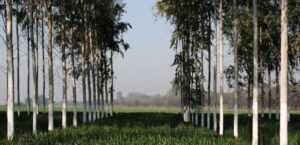
India- An Exporter of Wood and Wood Products – RK SAPRA IFS
- जनवरी 13, 2023
- 0
The land under Trees outside Forests (TOF) including agroforestry covers about 8.9% of geographical area of India and produces about 85 million cubic metres of wood annually as per the India State of Forest Report, 2021. Due to major thrust on conservation of forests, the availability of timber from forests has declined over the years and the farm wood could not make up for the shortfall of timber entirely.
The government liberalised the policy for import of timber in the nineties. As per the report Sustainable Trade of Wood and Wood based Products in India, 2021, 15 million cubic metres roundwood equivalent of wood and wood products for about INR 45,000 crore were imported.
Agroforestry was identified as one of the instruments for mitigating the effects of climate change in the union budget of 2022-23. The agroforestry mostly depends on private investments but needs some innovative policy interventions from the government which may facilitate its growth along with the development of wood based industries.

The time bound actions in this sector will create more income for the farmers and employment opportunities for rural youth which will reduce the rural distress. It will create business opportunities; earn tax revenue and foreign exchange. Hence, it is suggested that a booster dose may be provided to the agroforestry and wood-based industries in the union budget of 2023-24 for making India a net exporter of wood and wood products by the year 2030. An Eight-Point Action Plan for providing impetus to this sector is proposed as follows:-
1. The common (10-15) tree species which are planted in farmlands throughout the country, may be excluded from the purview of timber transit rules in all the states to allow their unhindered cultivation, felling, transport and usage.
2. A digital portal may be established for registration of all farm plantations which may help in certification of farm wood and quantification of the carbon sequestration by tree crops And may also provide hassle free felling and all-India transit permits for the species other than those exempted from felling and transport permission {Ministry of Environment, Forest and Climate Change (MoEFCC)}
3. Many state governments have already declared farm wood as an agricultural produce for collecting the marketing fees. Hence all the incentives, concessions and facilities like integration with Digital National Agricultural Market (eNAM), priority lending, kisan card, etc., which are available to agricultural crops may also be extended to tree crops (Ministry of Agriculture and Farmer Welfare (MoAFW))
4. Agroforestry Board on the pattern of Tea Board, Coffee Board, etc., may be set up for integrated development of agroforestry and wood-based industries. Large foreign and local industrial groups may be incentivised to manufacture quality wood products for local market and export (Ministry of Commerce and Industries (MoCI))
5. A high-powered committee consisting of MoEFCC, MoAFW and MoCI may be constituted to speed up the process of decision making in the agroforestry sector (Cabinet Secretariat).
6. Research and Development (R&D), extension and marketing of tree crops may be undertaken by the public and private sector organisations such as Indian Council of Forestry Research and Education (ICFRE), Indian Council of Agricultural Research (ICAR), ITC, WIMCO, etc., in a coordinated manner (MoEFCC, MoAFW and MoCI)
7. The licensing policy of wood-based industry which is based on farm wood may be liberalised (MoEFCC)
8. Review export and import policy to encourage domestic production of wood and wood products for local market as well as for export (MOCI)
A lot of recommendations regarding development of agroforestry sector have been made in the past by various committees and organisations but the pace of reforms is slow. It is high time that bold initiatives and reforms are undertaken at the level of the GOI and the states. The above-mentioned interventions will help in meeting the raw material demands of the woodbased industry, livelihood needs of the people living in and on the fringes of the forests, will increase the forest and tree cover while significantly contributing in mitigating the effects of climate change.

भारत-लकड़ी और लकड़ी के उत्पादों का एक निर्यातक
वनों के बाहर वृक्षों (टीओएफ) के तहत कृषि वानिकी सहित भूमि लगभग 8.9 प्रतिशत को कवर करती है। और इंडिया स्टेट ऑफ फॉरेस्ट रिपोर्ट, 2021 के अनुसार भारत का भौगोलिक क्षेत्र सालाना लगभग 85 मिलियन क्यूबिक मीटर लकड़ी का उत्पादन करता है। वनों के संरक्षण पर प्रमुख जोर देने के कारण पिछले कुछ वर्षों में वनों से इमारती लकड़ी की उपलब्धता में कमी आई है और खेत की लकड़ी, लकड़ी की कमी को पूरी तरह से पूरा नहीं कर सकती थी।
सरकार ने नब्बे के दशक में इमारती लकड़ी के आयात की नीति को उदार बनाया। भारत में लकड़ी और लकड़ी आधारित उत्पादों के सतत व्यापार, 2021 की रिपोर्ट के अनुसार लगभग 45,000 करोड़ रुपये के बराबर 15 मिलियन क्यूबिक मीटर गोल लकड़ी और लकड़ी के उत्पादों का आयात किया गया।
2022-23 के केंद्रीय बजट में जलवायु परिवर्तन के प्रभावों को कम करने के लिए एग्रोफोरेस्ट्री को एक उपकरण के रूप में पहचाना गया था। कृषि वानिकी ज्यादातर निजी निवेश पर निर्भर करती है। लेकिन सरकार से कुछ नवीन नीतिगत हस्तक्षेप की आवश्यकता है, जो लकड़ी आधारित उद्योगों के विकास के साथ-साथ इसके विकास को सुगम बना सके। इस क्षेत्र में समयबद्ध कार्रवाई से किसानों के लिए अधिक आय और ग्रामीण युवाओं के लिए रोजगार के अवसर पैदा होंगे, जिससे ग्रामीण संकट कम होगा। यह व्यापार के अवसर पैदा करेगा; कर राजस्व और विदेशी मुद्रा अर्जित करेंगें।
इसलिए, यह सुझाव दिया जाता है कि भारत को वर्ष 2030 तक लकड़ी और लकड़ी के उत्पादों का शुद्ध निर्यातक बनाने के लिए 2023-24 के केंद्रीय बजट में कृषि वानिकी और लकड़ी आधारित उद्योगों को बूस्टर खुराक प्रदान की जा सकती है। इस क्षेत्र को प्रोत्साहन प्रदान करने के लिए आठ-सूत्रीय कार्य योजना निम्नानुसार प्रस्ताव किया जाता हैः-
1. सामान्य (10-15) पेड़ की प्रजातियां जो पूरे देश में खेतों में लगाई जाती हैं, उन्हें सभी राज्यों में टिम्बर ट्रांजिट नियमों के दायरे से बाहर रखा जा सकता है ताकि उनकी खेती, कटाई, परिवहन और उपयोग की अनुमति दी जा सके।
2. सभी कृषि वृक्षारोपण के पंजीकरण के लिए एक डिजिटल पोर्टल स्थापित किया जा सकता है जो कृषि लकड़ी के प्रमाणन और वृक्ष फसलों द्वारा कार्बन प्रच्छादन की मात्रा का निर्धारण करने में मदद कर सकता है। और कटाई और परिवहन अनुमति {पर्यावरण, वन और जलवायु परिवर्तन मंत्रालय MoEFCC)} से छूट प्राप्त प्रजातियों के अलावा अन्य प्रजातियों के लिए परेशानी मुक्त कटाई और अखिल भारतीय पारगमन परमिट भी प्रदान कर सकते हैं।
3. कई राज्य सरकारों ने पहले ही विपणन शुल्क जमा करने के लिए खेत की लकड़ी को कृषि उत्पाद घोषित कर दिया है। इसलिए सभी प्रोत्साहन, रियायतें और सुविधाएं जैसे डिजिटल राष्ट्रीय कृषि बाजार (eNAM) के साथ एकीकरण, प्राथमिकता ऋण, किसान कार्ड, आदि, जो कृषि फसलों के लिए उपलब्ध हैं, को पेड़ की फसलों (कृषि और किसान कल्याण मंत्रालय ( MoAFW)) तक भी बढ़ाया जा सकता है।
4. कृषि वानिकी और लकड़ी आधारित उद्योगों के एकीकृत विकास के लिए चाय बोर्ड, कॉफी बोर्ड आदि की तर्ज पर कृषि वानिकी बोर्ड की स्थापना की जा सकती है। बड़े विदेशी और स्थानीय औद्योगिक समूहों को स्थानीय बाजार और निर्यात के लिए गुणवत्ता वाले लकड़ी के उत्पादों के निर्माण के लिए प्रोत्साहित किया जा सकता है (वाणिज्य और उद्योग मंत्रालय (MoCI))
5. कृषि वानिकी क्षेत्र (कैबिनेट सचिवालय) में निर्णय लेने की प्रक्रिया को तेज करने के लिए MoEFCC और MoAFW वाली एक उच्चाधिकार प्राप्त समिति का गठन किया जा सकता है।
6. भारतीय वानिकी अनुसंधान और शिक्षा परिषद (R&D), भारतीय कृषि अनुसंधान परिषद (ICFRE), ITC, WIMCO जैसे सार्वजनिक और निजी क्षेत्र के संगठनों द्वारा अनुसंधान और विकास (ICAR), वृक्ष फसलों का विस्तार और विपणन किया जा सकता है। आदि, एक समन्वित तरीके से (MoEFCC, MoAFW and MoCI)
7. लकड़ी आधारित उद्योग की लाइसेंसिंग नीति, जो फार्म वुड पर आधारित है, को उदार बनाया जा सकता है MOEFCC)
8. स्थानीय बाजार के साथ-साथ निर्यात (MOCI) के लिए लकड़ी और लकड़ी के उत्पादों के घरेलू उत्पादन को प्रोत्साहित करने के लिए निर्यात और आयात नीति की समीक्षा करें।
कृषि वानिकी क्षेत्र के विकास के संबंध में विगत में विभिन्न समितियों और संगठनों द्वारा बहुत सी सिफारिशें की गई हैं लेकिन सुधारों की गति धीमी है। यह उचित समय है कि भारत सरकार और राज्यों के स्तर पर साहसिक पहल और सुधार किए जाएं। उपर्युक्त हस्तक्षेप से लकड़ी आधारित उद्योग की कच्चे माल की मांग को पूरा करने में मदद मिलेगी, जंगलों में और उसके किनारे रहने वाले लोगों की आजीविका की जरूरतों को पूरा करने में मदद मिलेगी, वन और वृक्षों के आवरण में वृद्धि होगी जबकि जलवायु परिवर्तन के प्रभावों को कम करने में महत्वपूर्ण योगदान होगा।

































































